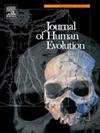First record of a Late Miocene hominid from North Macedonia
IF 3.1
1区 地球科学
Q1 ANTHROPOLOGY
引用次数: 0
Abstract
Known for over a century, the Late Miocene mammalian faunas of Veles, North Macedonia, have long been recognized for their scientific importance. However, hominid remains had not been previously reported from this fossil-rich area. Here, we report the discovery of an isolated upper molar from the vicinity of Veles—most likely from the Belushka locality—which constitutes the first known record of a Late Miocene hominid from the Republic of North Macedonia, and provide a review of the associated mammalian assemblages. The molar—probably an M3—exhibits a relatively large crown, broad and low cusps, inferred thick enamel, low dentine horns, and short, thick roots that are not markedly divergent. These characteristics, along with its inferred middle Turolian (MN12) age and Balkan provenance, suggest that the Veles molar belongs to an indeterminate member of the hominid tribe Graecopithecini. Together with the Graecopithecus freybergi mandible from Pyrgos Vassilissis, Greece, and an isolated graecopithecin upper premolar from Azmaka, Bulgaria, the Veles specimen provides rare additional evidence for the survival of apes well into the Turolian of the Balkan Peninsula. Furthermore, the Veles fossil faunas now document the co-occurrence of apes (Graecopithecini indet.) and monkeys (Mesopithecus), a pattern rarely observed in the Eurasian Miocene fossil record.
北马其顿中新世晚期人类的第一个记录
一个多世纪以来,北马其顿Veles的晚中新世哺乳动物群一直被认为具有重要的科学意义。然而,在这个化石丰富的地区,以前没有报道过人类遗骸。在这里,我们报告了在veles附近发现的一个孤立的上臼齿(很可能来自Belushka地区),它构成了北马其顿共和国晚中新世人科动物的第一个已知记录,并对相关的哺乳动物组合进行了回顾。臼齿(可能是m3)表现出相对较大的牙冠,宽而低的牙尖,推断出厚的牙釉质,低的牙本质角,短而粗的根,没有明显的分叉。这些特征,连同其推测的中图罗良(MN12)时代和巴尔干的来源,表明Veles磨牙属于古人类部落Graecopithecini的一个不确定成员。与希腊Pyrgos Vassilissis的graecithecus freybergi下颌骨,以及保加利亚Azmaka的一个分离的graecithecin上前臼齿一起,Veles标本为类人猿在巴尔干半岛的图罗利亚地区生存提供了罕见的额外证据。此外,Veles化石动物群现在记录了类人猿(Graecopithecini indet.)和猴子(Mesopithecus .)的共存,这在欧亚中新世化石记录中很少观察到。
本文章由计算机程序翻译,如有差异,请以英文原文为准。
求助全文
约1分钟内获得全文
求助全文
来源期刊

Journal of Human Evolution
生物-进化生物学
CiteScore
6.30
自引率
15.60%
发文量
104
审稿时长
3 months
期刊介绍:
The Journal of Human Evolution concentrates on publishing the highest quality papers covering all aspects of human evolution. The central focus is aimed jointly at paleoanthropological work, covering human and primate fossils, and at comparative studies of living species, including both morphological and molecular evidence. These include descriptions of new discoveries, interpretative analyses of new and previously described material, and assessments of the phylogeny and paleobiology of primate species. Submissions should address issues and questions of broad interest in paleoanthropology.
 求助内容:
求助内容: 应助结果提醒方式:
应助结果提醒方式:


